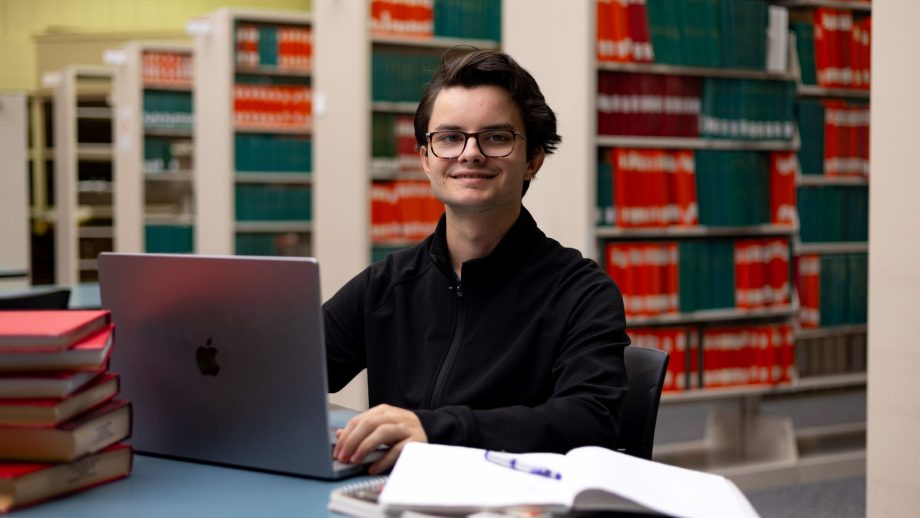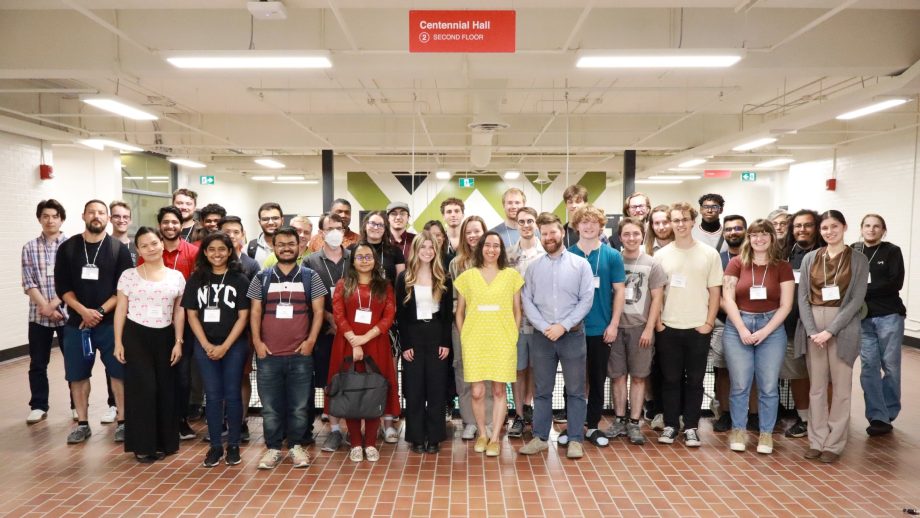Neutrons are extremely small, subatomic particles. Once separated from a nucleus, they are almost impossible to contain—moving at extreme speeds and capable of penetrating through a large distance of material.
To study a neutron is no easy task. Studying a faint electrical signal found within a neutron might seem unimaginable.
We were just like, ‘holy cow.’ We couldn’t believe it. This thing works. It’s unbelievable.
Dr. Jeff Martin
But that’s exactly what Dr. Jeff Martin, UWinnipeg physics professor and Tier 1 Canada Research Chair, is doing. And, he and his team are breaking particle physics records to do it.
“One way to measure really fine properties of something like a neutron is to just make lots and lots and lots of neutrons,” explained Dr. Martin.
This summer, Dr. Martin and his team at TRIUMF, Canada’s particle accelerator centre, broke the Canadian record for ultracold neutron production, producing 900,000 ultracold neutrons with each proton pulse.
“We opened the valve and they just start pouring out like crazy,” Dr. Martin said. “We were just like, ‘holy cow.’ We couldn’t believe it. This thing works. It’s unbelievable.”
The previous Canadian record, which was also set by Dr. Martin’s team, was 300,000. Now, he believes the team is just months away from breaking the world record for ultracold neutron production—work that could help scientists more precisely measure the separation of electric charges within a neutron, called the electric dipole moment.
“Even though you might not be able to, on an individual basis, measure the electric dipole moment of just one neutron very precisely. If you do it enough times, you can build up statistics,” said Dr. Martin. “We hope that by measuring this property of neutrons, we might discover something about why the universe is made of matter rather than antimatter.”
The project is hosted by TRIUMF, where Dr. Martin is chair of the Science Council and leads the international TRIUMF Ultracold Advanced Neutron (TUCAN) collaboration. Dr. Russell Mammei and Dr. Blair Jamieson from UWinnipeg are also playing key roles in the project, and UWinnipeg leads the project, with Dr. Martin identified as the Canadian co-spokesperson. The project is co-led by Dr. Shinsuke Kawasaki of the High-Energy Accelerator Research Organization (KEK) in Japan, while Canadian collaborators also include UBC, UManitoba, and UNBC.
Advancing science
Although the project might help us better understand how the universe was formed, Dr. Martin said new technologies being developed in the process could have impacts in other fields of science.
“We have to push technologies to new levels of precision,” Dr. Martin said. “We have precision magnetic sensors that are based on laser technology, that we developed in Winnipeg, that are sensitive enough to sense the magnetism from the electrical impulses in your brain.”
The project is also advancing the development of laser technology, neutron source technology, and even cryogenic technology.
“What we’re doing is taking neutrons out of the nucleus. When you do that, you get neutrons that are very hot, about a hundred billion degrees Celsius,” said Dr. Martin. “If you cool these neutrons down they take on interesting properties. And one of the properties is that they then start bouncing off of materials, rather than passing through them.”
Instead of studying just a small quantity of incredibly hot, fast-moving neutrons, Dr. Martin and his team can now study hundreds of thousands of neutrons that move more like a slow fluid.
“So you open the valve and they pour out,” Dr. Martin said. “We load all these neutrons into a bottle, and we measure their electric dipole moments just with them sitting in that bottle.”
UWinnipeg success
Dr. Mammei and Dr. Martin have created an ultracold neutron guide coating facility at UWinnipeg to transport neutrons from the source, where neutrons are produced and cooled, to the experiment where they are studied.
“All the pipes will be made in Dr. Mammei’s lab here at UWinnipeg,” Dr. Martin explained. “We use pulsed laser deposition to deposit diamond-like carbon onto the surfaces of tubes. It’s been developed over the years by others, but what’s unique about our facility is we can coat the inner surfaces of tubes, which is not a usual way that people want to do it.”
Dr. Martin has several graduate and undergraduate students working with him on this project. He said it’s rewarding to see the growth and success of his students.
“One of my former master’s students, Wolfgang Klassen, became a PhD student at UBC,” Dr. Martin said. “And he still remains working on a project that we started in the lab down the hall here, basically, making laser-based magnetometers. That graduate student became the world’s expert in it. It’s amazing and gratifying to see that happen.”
This research has been supported by grants led by The University of Winnipeg from the Canada Foundation for Innovation, the Canada Research Chairs program, the Natural Sciences and Engineering Research Council of Canada, Research Manitoba, the British Columbia Knowledge Development Fund, and various funding agencies in Japan and Mexico.





